
|   |

|   |
 e-mail: ukb7@rediffmail.com Surreally virtual! January 4, 2021 Occupying the major part of the year 2020 and throwing the prevailing normalcy "out of joint", civilized life was interrupted over the entire globe and amidst the incomprehensible pandemic, the question facing the artist community (among others) has been, how the challenge was to be overcome? Should it be a face-off, withdrawing oneself to an off-stage seclusion and new images and metaphors could be imagined not too far from one's learned grammar and cannons? Arguably, this seems to be the overall response for the classically groomed dance community. Alternatively, can it be a "bang-on" process, a confrontational mindset, where the vicious catastrophe is looked at in the face and invited for a dual, as it were? Again arguably, this appears to be the world view of the contemporary dancers: free from the canonized hasta mudras and vachik and sattvik abhinaya, they were out on a fantasy battle with the invading demon - little understood as it has been. The monthly editions of 'Sapphire Creations' spearheaded by Sudarshan Chakravorty, seems to spur on the team's dancers on a direct encounter with the unwelcome visitor and let loose the youthful band to confront the visiting scourge. This is what Sudarshan has to say, "Circumstances have changed but dance hasn't. We have danced on stage, danced on the streets, danced in cafes, bookstores, galleries, boardrooms. Now we will dance online. You will view us in a box. But in your mind's imagination, our energy and spirit will create a new world of movement, beauty, creativity and meaning for you. We will pervade borders with dance, be it physical or digital. We will Dance Vivid. Vivid is vivacious, alive and pulsating. This is the new now." 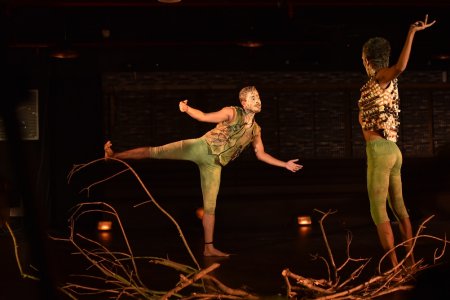 Catastrophe Their new monthly creation Edition 1 begins with the 8-minute item Catastrophe, with the choreographer Sudarshan's introduction again, "Unforeseen disaster strikes the human race and the survivors fail to comprehend the root of this collapse and wonder whether it was there around or has been nurtured inside them for ages. The question remains unanswered while human life is kept at stake waiting to be salvaged." Facing thorny branches of a discarded wood, two masked and scantily dressed male dancers gesticulate wildly, throw around their limbs and circumnavigate each other in utter incomprehension.They seem to be animated versions of Gogo (Estragon) and Didi (Vladimir) straight out of Samuel Becket's Waiting for Godot - equally bewildered and lost in a parched up land somewhere in an absurd world - and equally clueless about their salvation. The dancers are Abhishek Mitra and Vijay Sharma, with minimalist music by Philip Tan from Singapore. 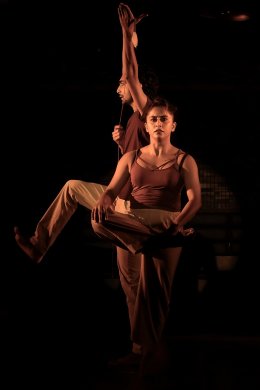 Pendulum For the second 9-minute item Pendulum, the choreographers are dancers themselves, Ankita Dutta Gupta and Kaushik Das, who have this to say for their piece. "Amidst fear and anxiety, humankind is making a conscious effort to strengthen resilience to fight back the challenging times. The 'Battle for Survival' continues and we are metabolizing the pandemic and allowing the 'New Normal' to evolve. Time is a pendulum between hope and despair, and if hope flags now, let it not be its last say!" The pas de deux is around a swinging pendulum, as though encapsulating time: past, present and future. The pulsating oscillation of the golden disc is perhaps a new paradigm, a reminder that all our times from the dim past to the unknown future are there to indicate that all the frantic efforts of the present to keep vibrating to its beat is probably futile. 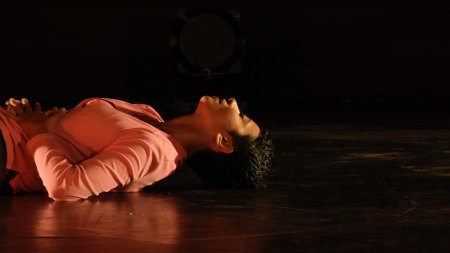 Losing Touch, Gaining Time For the penultimate 10-minute item Losing Touch, Gaining Time, the choreographer-dancer Paramita Saha (with music by Opafur Amalds) holds, "Space is crunching, the body is compressing, the heart is bursting, the breath is dying and the skin is shrivelling and cold. Time is growing, expanding, stretching, pulling apart, lagging behind and flailing desperately around. I am tiring, where are you?" This is a slow paced piece of solo dance, bordering on mono acting. Maintaining a serene stance, the dancer explores herself, almost in a painful process of self-discovery. With occasional writhing movements on the floor, she discovers herself at the end and seems to lie still with that realisation. Amald's music has almost the touch of the Western Classical, occasionally sounding like Beethoven's Ninth Symphony. 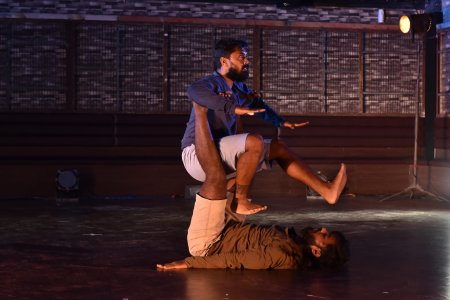 Déjà vu Déjà vu, the11-minutte end piece, is by a dancer-duo Sylvester Mardi and Purna Das, with choreography by Mardi. The latter has this to say, "This is a piece about how we try to recollect what we miss. The feeling of being in a familiar situation without knowing why or how". The dance has three clear segments of having Becket's Gogo and Didi back on stage, but now engaged in convulsive movements, revealing an existential anxiety about the known and the familiar for the present and a very restless prescience for the future. The first segment is distancing oneself from the other; the second is that of a tentative yet very vague dawn of understanding; and the third segment is that of coming to terms with the surroundings, with their two bodies exploring mutual hugging and retrieving a placid self reassurance -- arrived at by providing their bodies mutual support. The monthly Edition 2 starts with Sudarshan's introduction, "The contemporary dance movement in Kolkata, continuing to surpass the limits of the body and the imagination, must motivate those who never gave up dance. Circumstances have changed but dance hasn't. We will continue to pervade borders with dance be it physical or digital. We will continue to Dance Vivid: still vivacious, still alive and pulsating." 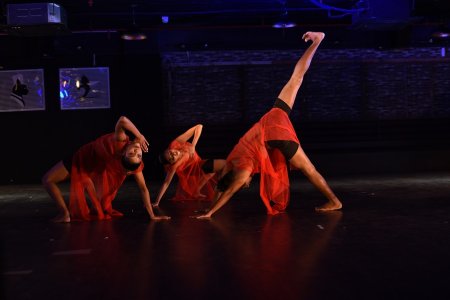 Directions The first 16-minute piece Directions has three dancers: Promita Karta, Souvik Roy and Ujjayee Banerjee, with their own choreography and minimalist music with automobile hoots, locomotive whistles and spacecraft swishing up creating an eerie amalgam. The overture is announced as: "Pause. Move. Slow down. Like traffic lights at the signal our lives are at the mercy of pause and play buttons of disease, lockdowns and uncertainties. Three gusts of abstract pulsating energy transmit and translocate. They are gentle streams sometimes; gushing rivers at others. They dart around space, finding direction, travelling and transmitting locomotion. They converge and diverge, at best they pulse. The hearts beat. Life continues..." The dancers - in striking contrast of upper red and lower black apparels - etch many patterns on floor, searches upwards, sitting and groping with wild gesticulations, and frantic pacing round and round in a multitude of movements. The pas de troix walk briskly, execute somersaults and show, on the whole, a vibrating restlessness of start-and-stop traffic movements. The threesome compositions remain visually quite arresting. 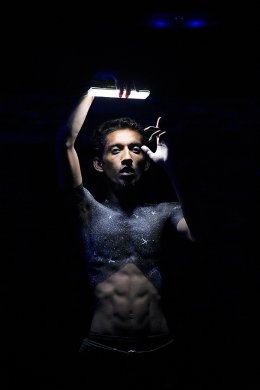 Lead Kindly Light Lead Kindly Light, the second 6-minute piece, is a visually very arresting solo by Vijay Sharma with his own choreography. The lone dancer carries a dazzlingly bright light tube in his hand that he uses to illuminate himself; places on floor to be looked up on; or walks around for brightening up both his countenance and the path to traverse. It is a short experimental piece, with the weary traveller seeking illumination in desperately dark alleys and perhaps receive enlightenment or, more likely, left groping in the dark. It is an interesting commentary on the "prevailing gloom", as biblically foreseen. Or, is it an "eternal perdition" to be doomed forever? 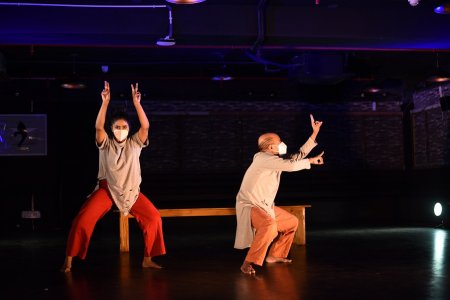 Hand stories Hand Stories, the final 14-minute piece presented by Sudarshan with Ankita Dutta Gupta, with movements devised by Sudarshan, is another very innovative piece depicting our normal lip-reading intuition -- that accompany verbal speech -- being ruled out. When faces are hidden behind masks, can the eyes speak the non-verbal lingo and should physical antics and gestures accompany the desperate desire to communicate? The piece is reminiscent of Edward Albee's The Zoo Story, the twosome theatre piece, enacted on a New York park bench that ends in a violent murder. Here the story is equally frantic and urgent, although not quite as gruesome as in Albee. It takes on many shades of indifference, growing acquaintance, budding interest between the two and the urgency to communicate, resulting in some one-sided dialogues and the failed attempts to use sign language of digital fingers and desperate gesticulations. Here is the director's summation, "We read lips when we listen to someone speak. We watch as well as listen. We read body language, facial expression and spoken word, all together. But our faces are masked now. Intentions too. Our lips do not move. Expressions remain hidden. The eyes twinkle in despair. Now it is left for the body to do the talking and for hands to hold gestures and signs, use metaphors of context, meaning and possibility. We signal in little zoom windows muted by others, often we mute ourselves. Emoticons struggle to express tiny nuances in feeling and tone. What is language then? How do we speak? Can we just watch hands do the talking?" It should be noted that Sapphire's new monthly Editions 1 and 2 were virtual programmes that were 'live-streamed' - both on Facebook and YouTube - without any editing. Moreover, they were held before a ticket buying audience, thus creating a potential of continued, paid patronage. Both these aspects are innovative and raise a new hope for dance - both classical and contemporary - under the "new normal". One looks forward to more Editions 3, 4, et al., from Sapphire in the months to come.  Dr. Utpal K Banerjee is a scholar-commentator on performing arts over last four decades. He has authored 23 books on Indian art and culture, and 10 on Tagore studies. He served IGNCA as National Project Director, was a Tagore Research Scholar and is recipient of Padma Shri. Post your comments Pl provide your name and email id along with your comment. All appropriate comments posted with name and email id in the blog will also be featured in the site. |